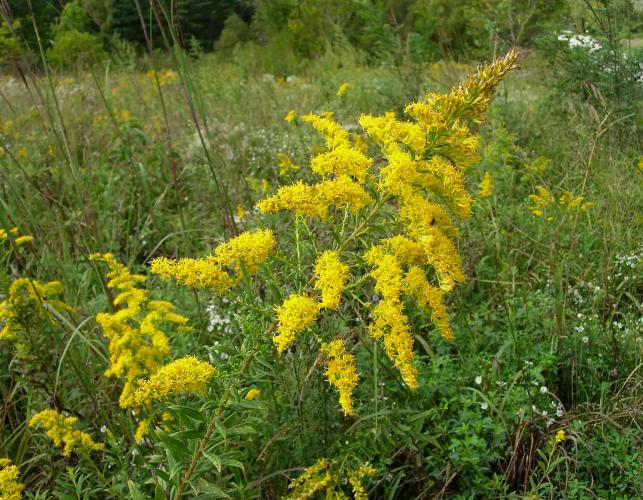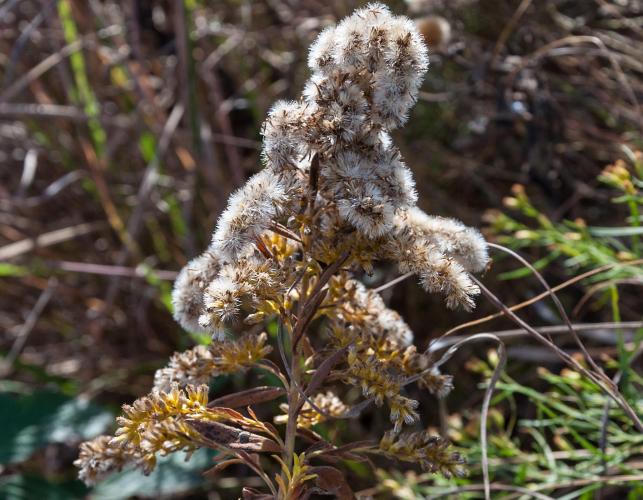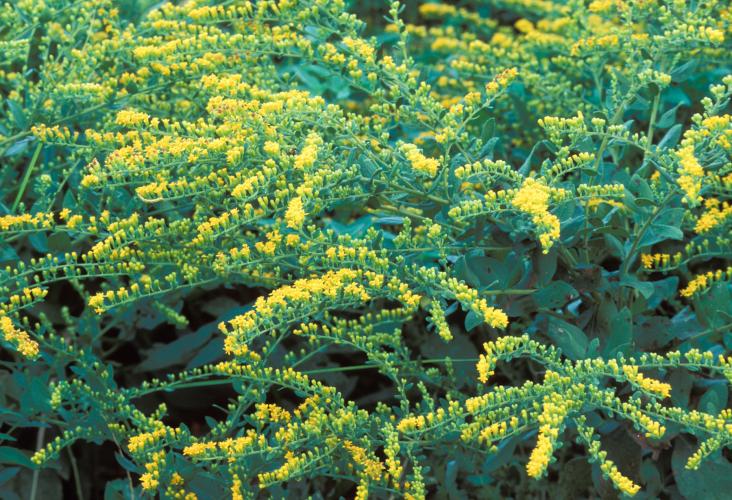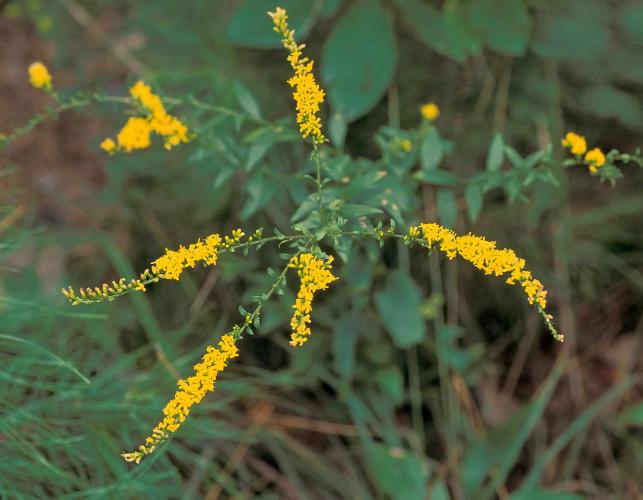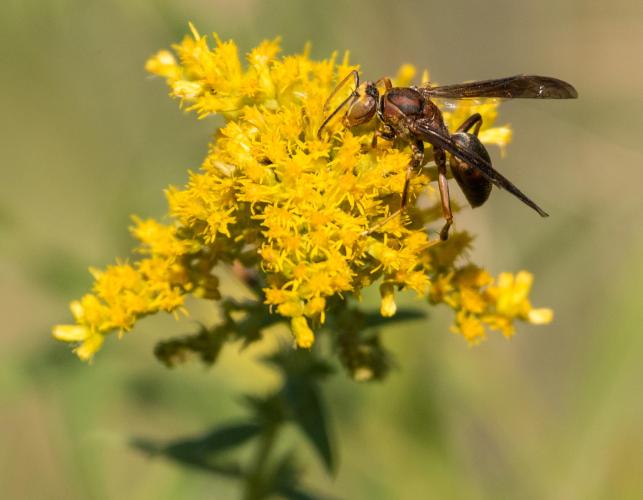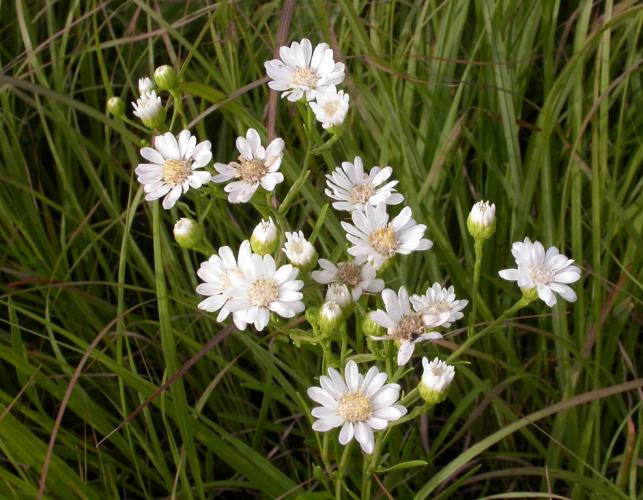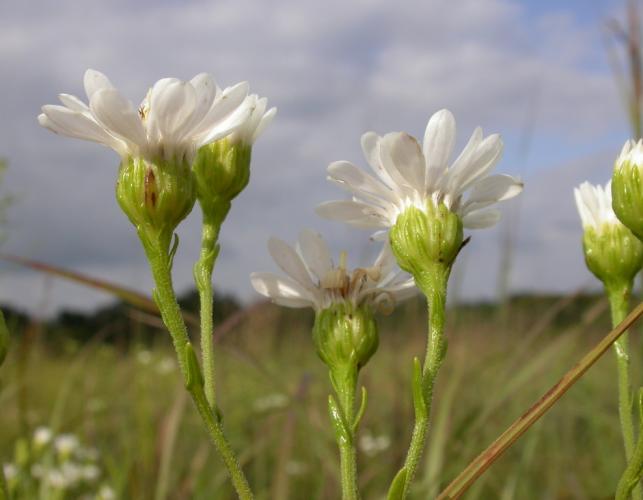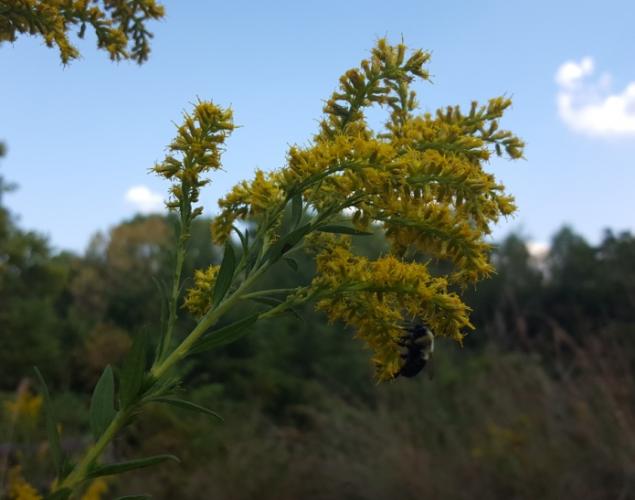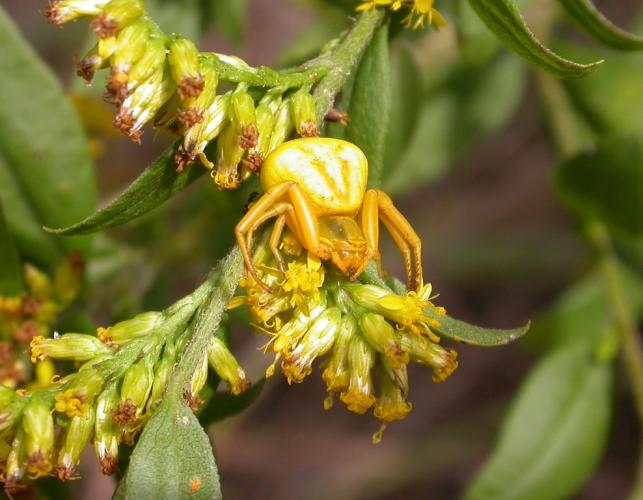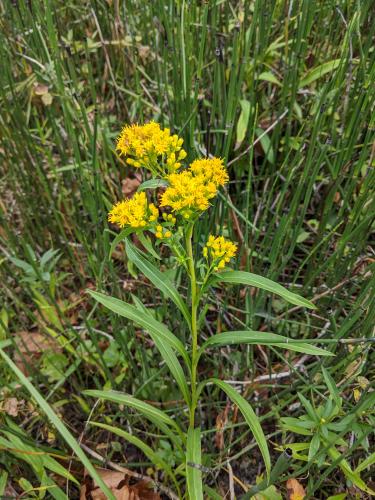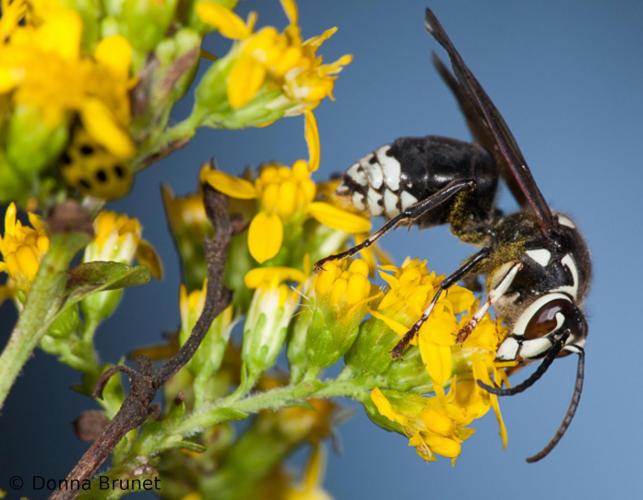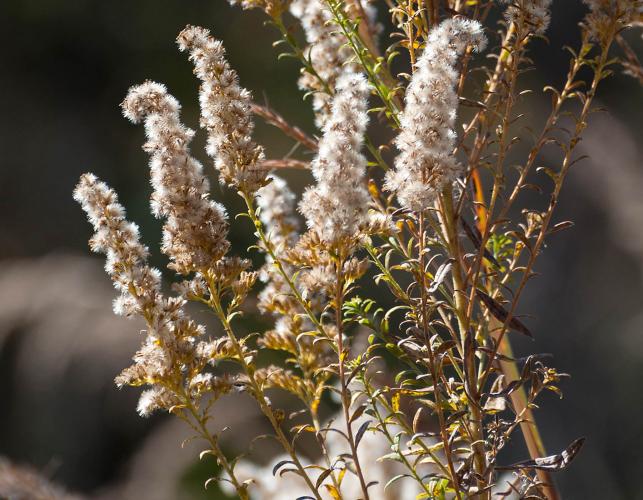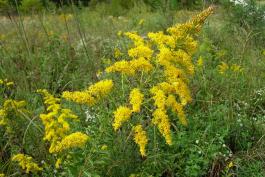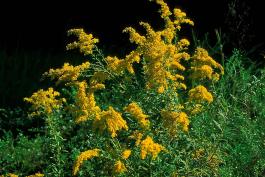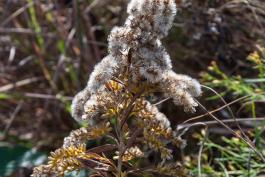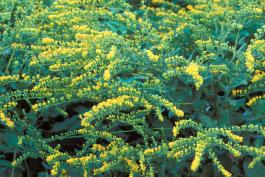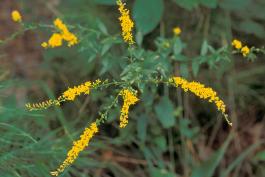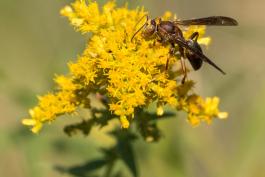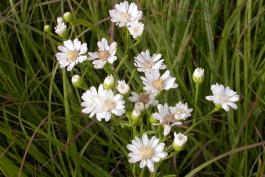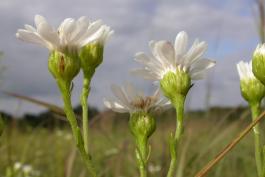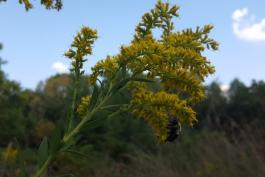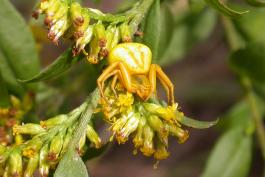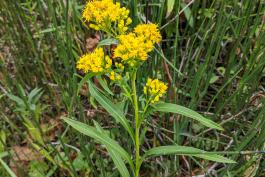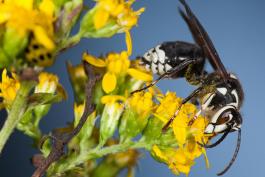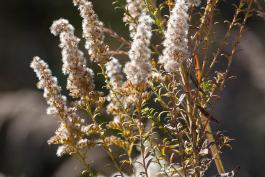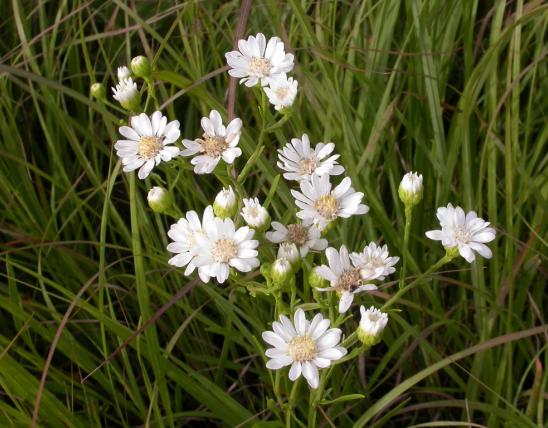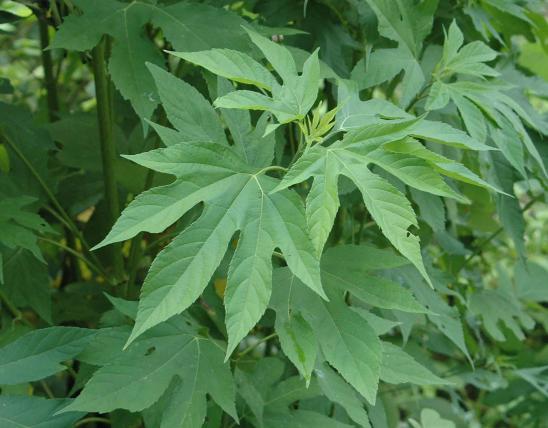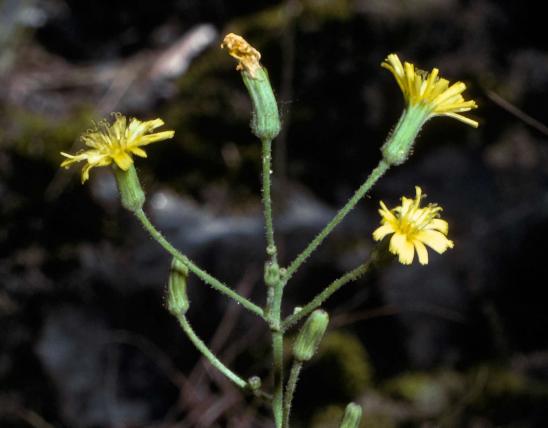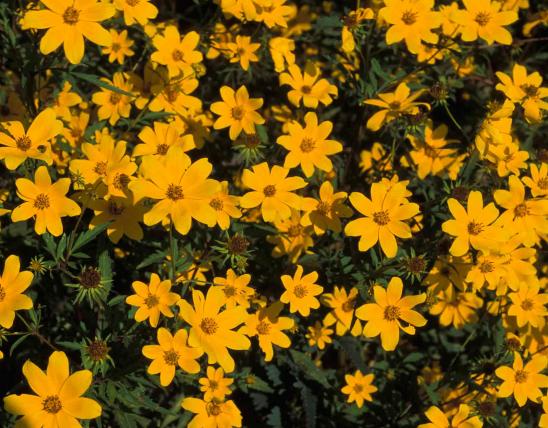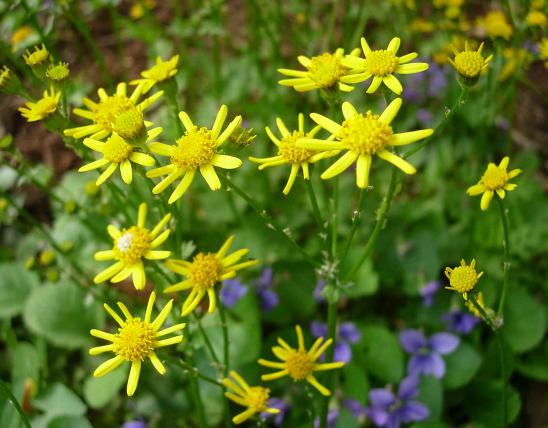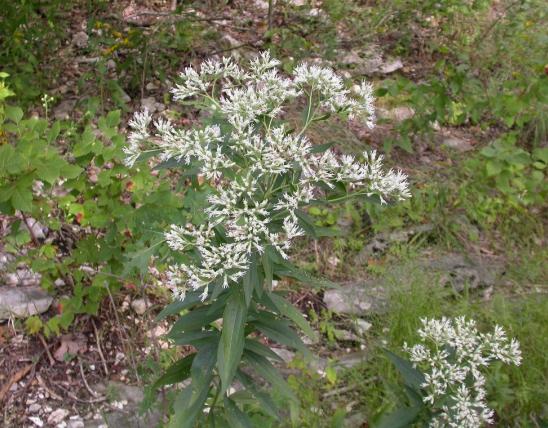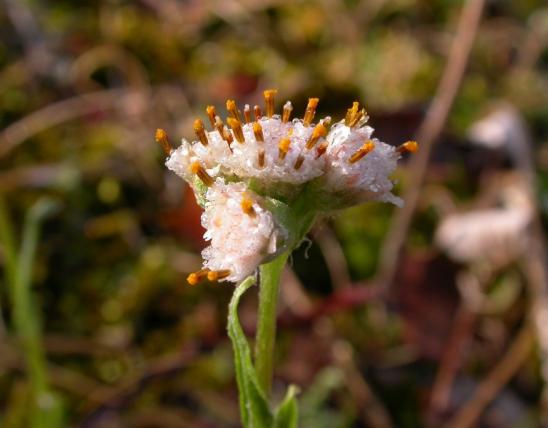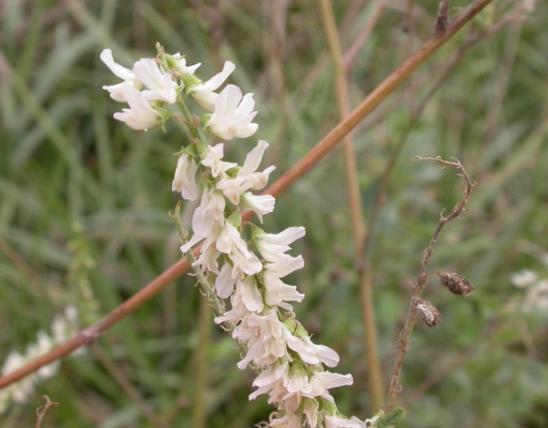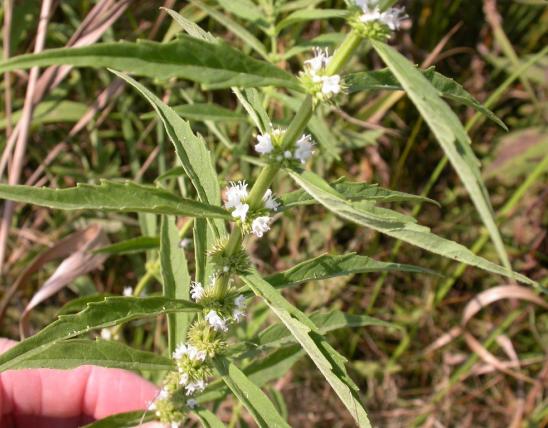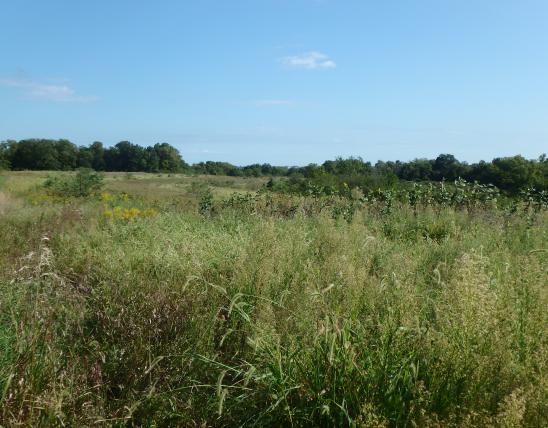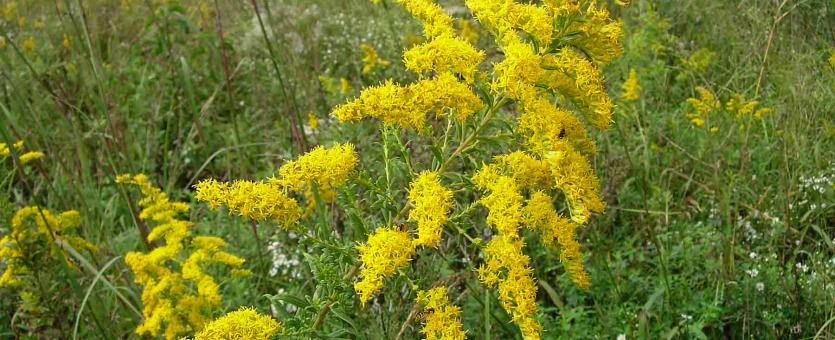
Goldenrod stems are slender and can be singular or several; the stalks are usually erect. Blooms June through December, depending on species. Flowers are in golden clusters spiraling or alternating along the upper portion of stems or branching near the top into smaller, flower-bearing branchlets. Each yellow (rarely white) “flower” is actually a tiny composite flowerhead, structurally similar to a daisy or sunflower. Leaves are alternate along the stem and are usually linear (very narrow, like grass) or lance-shaped, and usually with a pointed tip.
There are 23 species of goldenrods recorded from Missouri. They can be difficult to identify to species. As a group, however, the goldenrods are common and nearly unmistakable. To separate the species, specialists note details of the flowerheads and clusters of flowerheads, and of the basal, lower stem, and upper stem leaves. The following list is simply an introduction to Missouri's species.
- Tall goldenrod (S. altissima, including vars. altissima and gilvocanescens). Very widespread and common statewide. Large, to 7 feet tall. Stems hairy. Largest leaves, to 6 inches long, are at the middle of the plant, rough above and hairy below. Together, the flower clusters form a pyramid shape, with all the tiny flowerheads pointing upward. Stem galls made by midges and moths are common on this species. Blooms August–November.
- Atlantic or cut-leaf goldenrod (S. arguta, including vars. arguta, boottii, and caroliniana). Scattered in the Ozark and Ozark Border divisions, in upland forests, glades, ledges and bases of bluffs, stream and river banks. An attractive species that would be fine in a wildflower garden. Blooms June–October.
- Buckley's goldenrod (S. buckleyi). Scattered in the Ozark and Ozark Border divisions and on Crowley's Ridge in southeast Missouri, on glades, at bases, ledges, and tops of bluffs, upland forests, savannas, roadsides, and open, disturbed areas. Similar to downy goldenrod, but the leaves are thin (not thick), relatively wider, and have sharp teeth. Only blooms September–October.
- Blue-stemmed or wreath goldenrod (S. caesia). Scattered in the southern quarter of Missouri, almost entirely in the Ozark Division. Unlike most other goldenrods, this is mainly a woodland species, occurring on bases and ledges of shaded bluffs, stream and river banks, bottomland forests, and rich upland forests, and along roadsides. Look for it especially along sheltered bluffs and nearby lower terraces of streams. Not standing erect like most other goldenrods, the stems of this species arch gracefully like wands to about 3 feet long. The stems are bluish with a whitish-waxy coating. Leaves are lance-shaped and lack petioles (stalks). Flowerheads are small and arise at the leaf axils along the stem. This species would be good in a wildflower garden. Blooms August–October.
- Common goldenrod (S. canadensis var. hargeri). Scattered statewide, though uncommon in most of northern Missouri; found in prairies, upland forests, savannas, stream and river banks, pastures, old fields, edges of crop fields, railroads, roadsides, and other open, disturbed areas. This species is cultivated as an ornamental, including dwarf forms. Blooms July–October.
- Ozark, cliff, or Drummond's goldenrod (S. drummondii). Scattered mostly in the eastern half of Missouri; occurs on ledges and tops of calcareous bluffs and, rarely, banks of rivers. "Cliff goldenrod" is a good name for it. Height about 3 feet; stems arching, with soft hairs. Flowerheads arranged in short branches at the tips of stems. Resembles elm-leaved goldenrod, but Ozark goldenrod's stem leaves mostly have short petioles (as opposed to the leaves being stemless), and the leaves are wider-shaped, the blade only 1–2 times as long as wide. Blooms August–December.
- Broadleaf goldenrod (S. flexicaulis). Scattered in the eastern half of Missouri, uncommon farther west; occurs on bases and ledges of shaded bluffs, banks of streams and rivers, bottomland forests, and rich upland forests. Blooms July–October.
- Gattinger's goldenrod (S. gattingeri). Scattered in the Ozark and Ozark Border divisions. Occurs on calcareous glades and rock outcrops in upland prairies; rarely also on roadsides. Oddly, this plant occurs in glades in the northern half of the Ozarks and in the cedar barrens of Tennessee. Resembles Missouri goldenrod, but note the short, branched roots (not creeping rhizomes), 5–8 (not 7–13) ray florets, and absence of small clusters of leaves in the axils of the main leaves. Blooms July–October.
- Late, tall, or giant goldenrod (S. gigantea). Scattered nearly statewide; occurs in a wide variety of habitats, but especially in open, disturbed areas. This species is relatively glabrous (smooth; hairless). Blooms July–October.
- Hairy goldenrod (S. hispida var. hispida). Scattered in the Ozark and Ozark Border divisions. Occurs in upland forests, ledges and tops of bluffs, and roadsides, frequently on acidic soils. One of the easier goldenrods to identify: usually single-stemmed; leaves and stems are noticeably hairy; basal and lowest stem leaves are the largest on the plant. Blooms July–October.
- Early goldenrod (S. juncea). Scattered in the southern half of Missouri and in the northeastern quarter. Occurs in prairies, glades, savannas, forest openings, railroads, roadsides, and other open disturbed areas. Reaches 4 feet tall, branching near the top into curved, flower-bearing branchlets; leaves are willowlike, narrow, variably toothed; lower leaves may be a foot long but become shorter toward the top. (Despite the name of this species, downy and rough goldenrods actually bloom earlier, starting in May.) Blooms June–October.
- Missouri goldenrod (S. missouriensis var. fasciculata). Scattered nearly statewide in a wide variety of open habitats, ranging from the loess hill prairies of northwest Missouri to old fields, railroads, and roadsides. Leaves on the lower part of stem have 3 main veins for most of the blade length. Resembles Gattinger's goldenrod, but note the creeping rhizomes (not short, branched roots), 7–13 (not 5–8) ray florets, and small clusters of leaves in the axils of the main leaves in the middle and upper portions of the flowering stem. Blooms July–October.
- Old-field or gray goldenrod (S. nemoralis, including ssp. decemflora and ssp. nemoralis). Scattered nearly statewide in a wide variety of open habitats; it is characteristic of old fields and other open, grass-dominated habitats. Reaches 2–3 feet tall. Stem and leaves with dense, curved gray hairs, making the plant look grayish-green. The flower cluster is typically a narrow pyramid shape that arches over slightly at the top, with all the flowerheads oriented upward. Blooms July–November.
- Sweet or fragrant goldenrod (S. odora var. odora). Scattered in the southeastern portion of the Ozark Division and also on Crowley's Ridge; occurs in openings of moist upland forests, margins of spring branches, and savannas, and in old fields and roadsides. The crushed foliage smells like licorice (anise). Blooms July–September.
- Rough-leaved goldenrod (S. patula var. patula). Scattered in the eastern portion of the Ozark, Ozark Border, and Mississippi Lowlands divisions. Occurs in fens, acid seeps, swamps, seepy banks of streams, and ledges of calcareous bluffs. Blooms August–October.
- Downy or woodland goldenrod (S. petiolaris). Scattered mostly south of the Missouri River. occurs in glades, bases, ledges, and tops of bluffs, openings in forests, and savannas; also in pastures and roadsides. To 3 feet tall; stems smooth at the base and hairy at the top. Leaves are thick and firm; upper surface of leaves is hairy. Flowers are clustered at the stem tips in a column shape. It is recommended for wildflower gardens. This attractive species has relatively large flowerheads and is one of the earliest species to start flowering in our state. Blooms May–November.
- White upland aster, sneezewort aster, upland white goldenrod, or white flat-top goldenrod (S. ptarmicoides; formerly Aster ptarmicoides). With its white, petal-like ray flowers and pale disc florets, this is truly the oddball of the goldenrods: it looks much more like a white-flowered aster. It used to be considered an aster, but because it hybridizes with goldenrods and not with asters, its true genetic relationship is clear. Scattered in the Ozark and Ozark Border divisions, in glades, blufftops, upland prairies, pastures, railroads, and roadsides. Blooms July–September.
- Rough goldenrod (S. radula). Scattered in the southern half of Missouri, and north locally to Monroe and Marion counties, but absent from nearly all of the Bootheel, in forest openings, bluffs, glades, and rarely upland prairies; also roadsides. One of the earliest goldenrods to bloom in Missouri. Blooms May–October.
- Riddell's goldenrod (S. riddellii). Scattered to uncommon in the Ozark and Ozark Border divisions, it occurs only in high-quality calcareous seepage wetlands along streams, and especially fens. It has narrow leaves, shiny stems, and rounded clusters of flowerheads that are solitary or in small clusters at the branch tips. Blooms August–October.
- Stiff or rigid goldenrod (S. rigida, including ssp. glabrata, ssp. humilis, and ssp. rigida). Scattered nearly statewide, but uncommon in the eastern part of the Ozarks and apparently absent from the Bootheel. Occurs in prairies, glades, forest openings, and uncommonly stream and river banks; also old fields, pastures, roadsides, and other open disturbed areas. Reaches 5 feet tall; the plant is usually hairy, making it look somewhat grayish. Leaves are rough, leathery, and stalkless and get smaller the higher on the stem. Flowerheads are relatively large, with rather large petal-like ray florets making the flowerheads look a little like asters; the overall flower arrangement is dense and flat-topped or rounded. This is an attractive species sometimes sold in native wildflower nurseries for gardeners. Blooms August–October.
- Rough-leaved or rough-stemmed goldenrod (S. rugosa, including ssp. aspera and ssp. rugosa). Scattered, but mostly in the southeastern quarter of Missouri. Prefers wetter habitats than most other goldenrods: bottomland forests, banks of streams, rivers, spring branches, fens, bases and ledges of bluffs; less common in upland forests; also pastures and roadsides. Blooms August–October.
- Prairie or showy goldenrod (S. speciosa, including vars. rigidiuscula and speciosa). Scattered nearly statewide, but uncommon in most of the Ozark, Ozark Border, and Mississippi Lowlands divisions. Mainly grows in upland sites: prairies (including the loess hill prairies of northwest Missouri), bluff ledges, upland forests, glades, but also on banks of streams and rivers and rarely in swamps, plus roadsides and railroads. Unbranched, to 3 feet tall; flowerheads arise in a spiral around the stalk and are relatively large (for goldenrods); leaves are alternate, lance-shaped, long-pointed, with leaf stems, and have rounded teeth. This is another favorite goldenrod for ornamental and prairie plantings. Blooms August–November.
- Elm-leaved goldenrod (S. ulmifolia, including vars. palmeri and ulmifolia). Scattered nearly statewide in a wide variety of open habitats. Especially characteristic of dry bluffs. Stems single, hairless, to 4 feet tall. Flower clusters are usually fairly open, with lower branches widely spaced, long, and arching. Resembles Ozark goldenrod, but elm-leaved goldenrod's stem leaves mostly are sessile (stalkless, as opposed to leaves having short petioles), and the leaves are more slender-shaped, the blade 2–8 times as long as wide. Blooms August–November.
Height: commonly to about 3–4 feet.
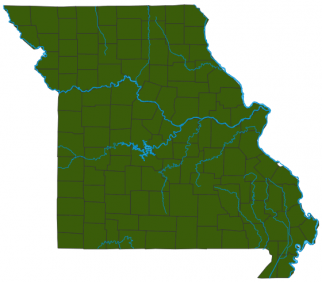
Statewide. Different species are found more or less commonly in different parts of the state.
Habitat and Conservation
Found in a variety of habitats, depending on the species. Most are associated with prairies, fields, pastures, openings in woods, roadsides, and other sunny places.
Status
From common to scattered to uncommon, depending on species.
Human Connections
Because goldenrods produce showy blooms about the same time as wind-pollinated (but far less showy) ragweeds and pigweeds, goldenrods are often blamed for hay fever. But goldenrods have sticky pollen carried by insects and are not the culprits!
Goldenrods are beloved wildflowers that decorate Missouri roadsides in late summer and early fall. Their distinctive color — goldenrod yellow — is especially striking when they bloom alongside the vibrant purple of ironweeds, or the deep scarlet of sumac leaves. All this color in the landscape is good for the spirit — and for tourism revenue.
After the flowers are gone, the fluffy clusters of seeds are lovely in their own way. They catch your eye when you're hiking in fall.
Many goldenrod species are grown as ornamentals and are available at plant nurseries.
Native Americans used the plants medicinally.
Rubber can be made from the sap.
Some states have adopted goldenrods as their official flower. Nebraska and Kentucky both selected giant goldenrod (S. gigantea) as their state flower. South Carolina selected tall goldenrod (S. altissima) as its state wildflower.
Ecosystem Connections
Many insects lay eggs on goldenrods — in fact, the plant is a miniature habitat for a surprisingly large number of species. Moth larvae and other insects grow inside the stems, frequently creating galls, enlarged portions of the stems that develop in response to the insect's presence. The galls of many gall-making insects are plundered by parasitic wasps, which lay their eggs on the larvae. Some woodpeckers also eat the larvae at the centers of the galls.
In late summer and early fall, watch the insect activity on a colony of goldenrods. Goldenrods, which typically bloom late in the growing season, are a critical nectar source for many insects, including bees, butterflies, wasps, beetles, flies, and more. For many, it is their last food source before freezing weather puts a stop to nearly all insect activity. Spiders, ambush and assassin bugs, and other predators lay in wait for these pollen- and nectar-feeders.
Once the flowers mature into fluffy-topped seeds, a long list of birds eat the seeds. Mammals such as mice use the fluff and other fibrous materials to line their nests in preparation for the winter.
